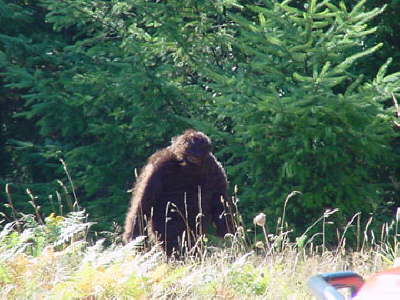A British research has concluded that the legendary Himalayan yeti may in fact be a sub-species of brown bear.
DNA tests on hair samples carried out by Oxford University genetics professor Bryan Sykes found that they matched those from an ancient polar bear.
Prof. Bryan Sykes subjected the hairs to the most advanced tests available.
He says the most likely explanation for the myth is that the animal is a hybrid of polar bears and brown bears.
Prof. Bryan Sykes conducted the DNA tests on hairs from two unidentified animals, one from Ladakh – in northern India on the west of the Himalayas – and the other from Bhutan, 800 miles further east.

The legendary Himalayan yeti may in fact be a sub-species of brown bear
The results were then compared with the genomes of other animals that are stored on a database of all published DNA sequences.
Prof. Bryan Sykes found that he had a 100% match with a sample from an ancient polar bear jawbone found in Svalbard, Norway, that dates back to between 40,000 and 120,000 years ago – a time when the polar bear and closely related brown bear were separating as different species.
The species are closely related and are known to interbreed where their territories overlap.
The sample from Ladakh came from the mummified remains of a creature shot by a hunter around 40 years ago, while the second sample was in the form of a single hair, found in a bamboo forest by an expedition of filmmakers around 10 years ago.
Prof. Bryan Sykes said that his results were “completely unexpected” and that more work needed to be done interpreting them.
He said that while they did not mean that “ancient polar bears are wandering around the Himalayas”, there could be a sub-species of brown bear in the High Himalayas descended from an ancestor of the polar bear.
“Or it could mean there has been more recent hybridization between the brown bear and the descendant of the ancient polar bear,” Prof. Bryan Sykes said.
A British-Swiss team will use DNA testing to investigate the origins of remains claimed to be from yeti and bigfoot.
The project will examine hair, bone and other material from a collection amassed by a Swiss biologist – and will invite submissions from elsewhere.
Many cultures relate legends of hairy, humanoid creatures that lurk in the wilds, rarely seen.
But material claimed to be from such creatures have never been subjected to modern scientific techniques.
“It’s an area that any serious academic ventures into with a deal of trepidation… It’s full of eccentric and downright misleading reports,” said Prof. Bryan Sykes, from Oxford University.
The researchers will apply a systematic approach and employ the latest advances in genetic testing, aiming to publish in peer-reviewed scientific journals.
“There have been DNA tests done on alleged yetis and other such things but since then the testing techniques, particularly on hair, have improved a lot due to advances in forensic science,” the Oxford geneticist told Reuters news agency.

A British-Swiss team will use DNA testing to investigate the origins of remains claimed to be from yeti and bigfoot
Modern testing could get valid results from a fragment of a shaft of hair, added Prof. Bryan Sykes, who is leading the project with Michel Sartori, director of the Lausanne Museum of Zoology.
A 1951 expedition to Mount Everest famously returned with photographs of giant footprints in the snow, fuelling speculation about giant Himalayan creatures, unknown to science.
Since then, many eye-witness reports of such creatures have emerged from remote regions of the world.
These humanoid beasties are variously known as the “yeti” or “migoi” in the Himalayas, “bigfoot” or “sasquatch” in North America, “almasty” in the Caucasus mountains and “orang pendek” in Sumatra, but there are many others.
Tests up to now have usually concluded that alleged yeti remains were in fact human. But, said Prof. Bryan Sykes, “there has been no systematic review of this material.”
The project will focus on an archive of remains held at the Lausanne museum that was assembled by Bernard Heuvelmans, a Belgian-French biologist who investigated reported yeti sightings from 1950 up to his death in 2001.
Other institutions and individuals will also be asked to send in details of any possible yeti material.
Aside from the yeti question, Prof. Bryan Sykes said he hoped the project would add to the growing body of knowledge on the interaction between different human species in the past.
“In the last two years it has become clear that there was considerable interbreeding between Homo sapiens and Neanderthals … about 2% to 4% of the DNA of each individual European is Neanderthal,” he said.
Those who are favorable to the idea of as-yet undescribed creatures say the yeti and orang pendek could represent survivals of Homo erectus, Homo floresiensis (the Indonesian “Hobbit”) or Gigantopithecus – a giant ape that once inhabited the forests of East Asia. The idea has even spawned the term “cryptozoology” to describe the search for such beasts.
Others are highly skeptical of such tales, and consider the subject unworthy of serious scientific investigation.
Asked about the project’s chances of success, Prof. Bryan Sykes said: “The answer is, of course, I don’t know,” adding, “it’s unlikely, but on the other hand if we don’t examine it we won’t know.”


